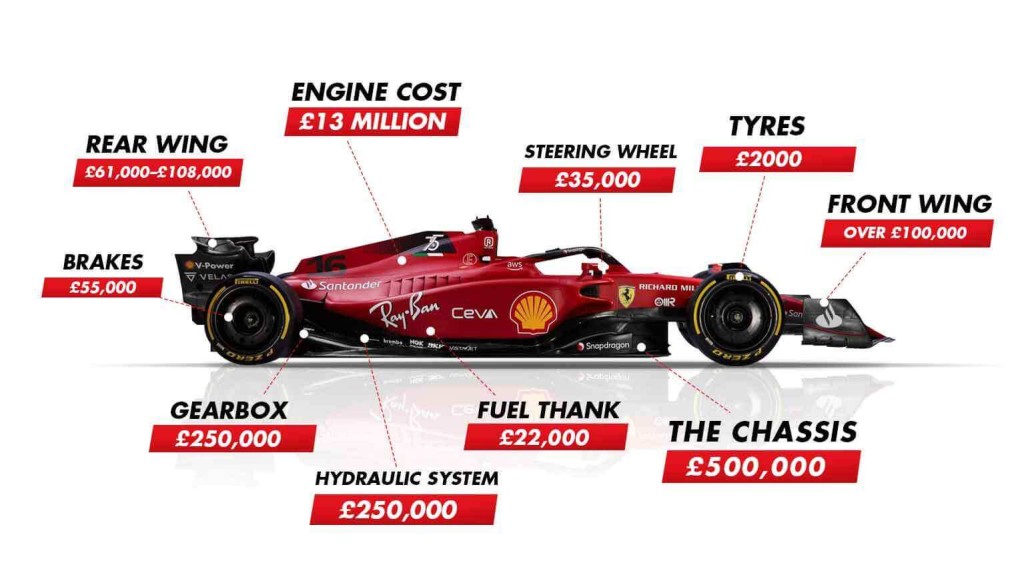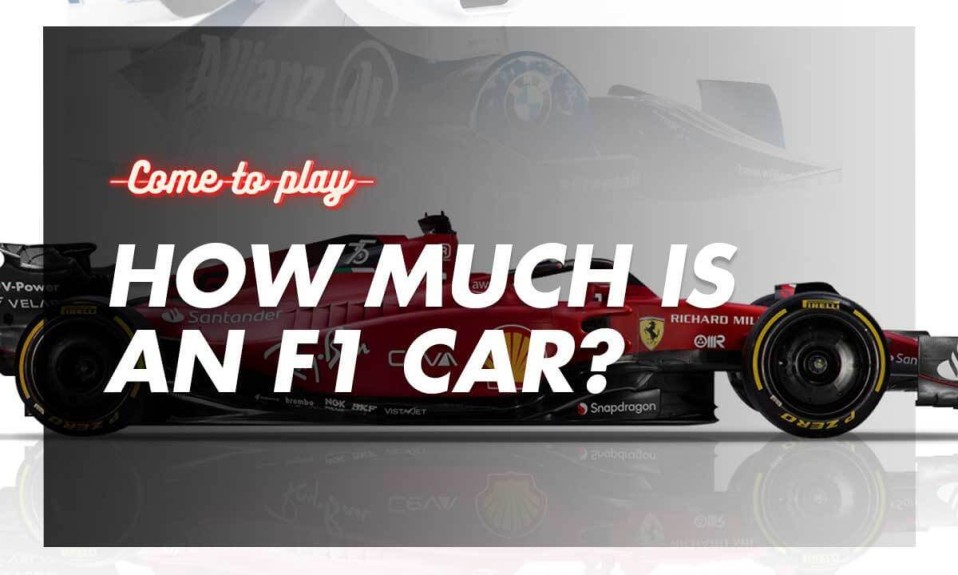“How much is a Formula 1 car?” is a question many fans ask themselves when daydreaming of driving the fastest racing car in the world.
Well, the total F1 car price can rise above £14.6 million, but we break down the budget to find out why it costs so much.
Let’s start our engines!
How Much Is an F1 Car?

While difficult to pinpoint the exact F1 car cost of a Grand Prix car, we can estimate it between £13 million and £15 million after considering the individual components’ prices.
But that’s the cost of the real deal—an actual F1 car driven during the current official season—which no private individual could purchase and own.
What About Used F1 Cars?
Wealthy fans who want an actual F1 car could still get their hands on one via auctions or private sales of second-hand models with actual racing history.
These deluxe F1 cars are often ready-to-drive, but you really need a skilled racer behind the wheel, especially in the older vehicles, as they are unruly beasts.
As for the price of the F1 car in such cases, it depends on their history and current condition. For instance, a Senna-McLaren or a Schumacher-Ferrari won’t dip below £4.5 million, but the engine-less Jenson Button’s BAR Honda from 2004 was on sale for ‘just’ £60,000.
The most expensive F1 car sold at an auction was the 1954 Championship-winning Mercedes driven by Juan Manuel Fangio at a price of £26 million.

Are There Any F1 Car Replicas?
For serious collectors who simply like looking at or pushing around true-size replicas, F1, in collaboration with the teams, offers official 1:1 scale show cars starting at £100,000.
You can choose between legendary models from F1’s history or the latest show cars currently running on the grid, representing the actual cars’ chassis and livery with a set of wheels.
The not-so-wealthy fans can always find cheaper and smaller replicas from either official or third-party manufacturers for as low as £10 for 1:43 models.
You might also be interested in: Why do F1 drivers get weighted?
What Is the Individual Cost of F1 Car Components?
To understand the astronomical Formula 1 car price calculations, let’s take a closer look at the approximate manufacturing costs of the car’s major components.
1. How much does an F1 engine cost?
As the most technologically-advanced and one of the most powerful car engines anywhere, which can produce horsepower above 1,000 hp, the F1 power unit is also the most complicated component to manufacture so it comes at a pretty penny.
For instance, the latest F1 car value estimates put the full cost of an F1 engine at almost £13 million, which ultimately comes up to a massive 85% to 90% of the total price.
This staggering number is not so surprising when you consider the difficulty of producing and fitting together each power unit component, including the internal combustion engine, MGU elements, turbocharger, batteries, and control electronics.
2. How much does an F1 car chassis cost?
The second most expensive component contributing with £500,000 to the total F1 car price is the chassis—the central part of the car and the driver’s office in a way.
Also known as the monocoque or the ‘survival cell’, the chassis is integral to the car’s performance and safety, and its high cost is due to its 12-layer carbon construction, which makes it twice as strong as steel, but five times lighter.
Naturally, this protective shell must be made from the strongest material there is in order to properly protect not only the car’s priceless components but the driver as well.
Note: As a crucial part of the F1 chassis as it has significantly reduced the number of driver injuries and deaths, the mandatory halo system costs around £12,000 to build.
3. How much do F1 wings cost?
The rear wing with its DRS system (£61,000–£108,000) and the front wing and the nosecone (over £100,000) attach to the chassis and have one job only: to produce the much-needed downforce that allows F1 cars to dash through corners at incredible speeds.
For instance, the fastest F1 corner is Silverstone’s Copse, with speeds recorded at about 300 kph, which is the portion of the track where the truly great F1 drivers stand out from the rest.
Also read: Do F1 drivers pee during a race?
4. How much does an F1 gearbox cost?
The semi-automatic gearbox used by F1 teams is arguably the most advanced in motorsports and one of the car’s most expensive components, with a £250,000 price tag.
Takes a lot of engineering ingenuity to create a sequential paddle-shift system with 8 forward and 1 reverse gear that allows for seamless shifting at around 50 milliseconds.
5. How much does an F1 fuel tank cost?
The cost of the F1 car fuel tank is around £22,000 as it must be built using a combination of polyurethane and Kevlar to make it fire-resistant and almost indestructible.
The ribbed fuel bag is also conveniently placed behind the driver’s seat to which it is attached so it does not collapse as the fuel is spent.
6. How much does an F1 steering wheel cost?
Gone are the days when the steering wheel was only used for steering, as nowadays, it’s a full-blown computer with six paddles, nine rotary switches, and 20 buttons.
Coupling its electronic control unit are silicon grips and a costly carbon fibre material, which ultimately bring its price up to £35,000. That’s one expensive gamepad right there.
Also read: What does the safety car do in F1?
7. How much does an F1 hydraulic system cost?
Due to the intricate design and interconnectivity of the car’s hydraulic system, its manufacturing process adds a significant cost (around £123,000) to the overall Formula 1 car price.
All in all, the vehicle’s hydraulics control ten separate systems: everything from power steering and shifting gears to the clutch, differential, throttle, and the DRS system.
8. How much do F1 brakes cost?
The car braking system carries a price tag of £55,000 as it comprises high-tech brake disks, pads, callipers, master cylinders, disk bells, and brake pedals with an accelerator.
Despite functioning similarly to standard road vehicles, an F1 car’s brake system includes several innovative technologies that allow for precise braking and cooling to maintain complete control around corners at the incredible speeds these cars are performing.
9. How much do F1 car tyres cost?
Every F1 team uses standardised tyres provided by a single manufacturer—Pirelli.
However, unlike regular road car tyres, these products are bespoke to Formula 1 cars and come in several compounds that suit different weather and track conditions.
Currently, a single tyre costs about £500, with a full 4-tyre set coming up to £2000; however, considering teams use several sets during two-hour races, the costs multiply.
10. Any additional costs?
When deducing the price of an F1 car, we should also consider the floors and bargeboards, which are responsible for contributing to the car’s downforce (£100,000) and several ancillaries like the chassis loom, wheel bearings, and driveshafts, which add up to £36,000.
How Do Cost Caps Affect F1 Teams?
In an effort to level the racing field and bring teams’ performance closer together, F1 has started implementing yearly cost caps in 2021 with a budget limit of $145 million.
Since then, the cost caps have been decreasing by $5 million each year, with $140 million allowed for the 2022 season, and a preset $135 million cap for 2023.
However, due to the economic changes brought on by recent world events and the rise of inflation and transportation costs, the new budget limits have been increased by 3.1%.
The budget caps cover team expenses related to car development and personnel salaries, excluding marketing costs, driver wages, and the salaries of the three highest-paid employees.
Before the introduction of these financial regulations, there was a massive gap between the sport’s richest teams (which were spending upwards of $450 million) and the backmarkers who simply couldn’t compete as their cars were always lacking due to limited budgets.
Did you know: As one of the sport’s greats, Lewis Hamilton has a yearly salary of £36 million, whereas the new drivers on the grid are paid as low as £900,000.
Bottom Line
Most teams avoid disclosing the amount they spend on their cars so their competitors are in the dark as to the car design aspects they are aiming to improve. Therefore, there is no definite answer to the question, “How much is a Formula 1 car?
However, by collecting bits and pieces of information from F1 and the teams’ staff and discovering the costs of individual components, we come up with a rough estimate of £14.6 million for a single F1 car—a hefty chunk of change, right?

